traction control BMW M3 CONVERTIBLE 2012 Owners Manual
[x] Cancel search | Manufacturer: BMW, Model Year: 2012, Model line: M3 CONVERTIBLE, Model: BMW M3 CONVERTIBLE 2012Pages: 255, PDF Size: 6.32 MB
Page 15 of 255
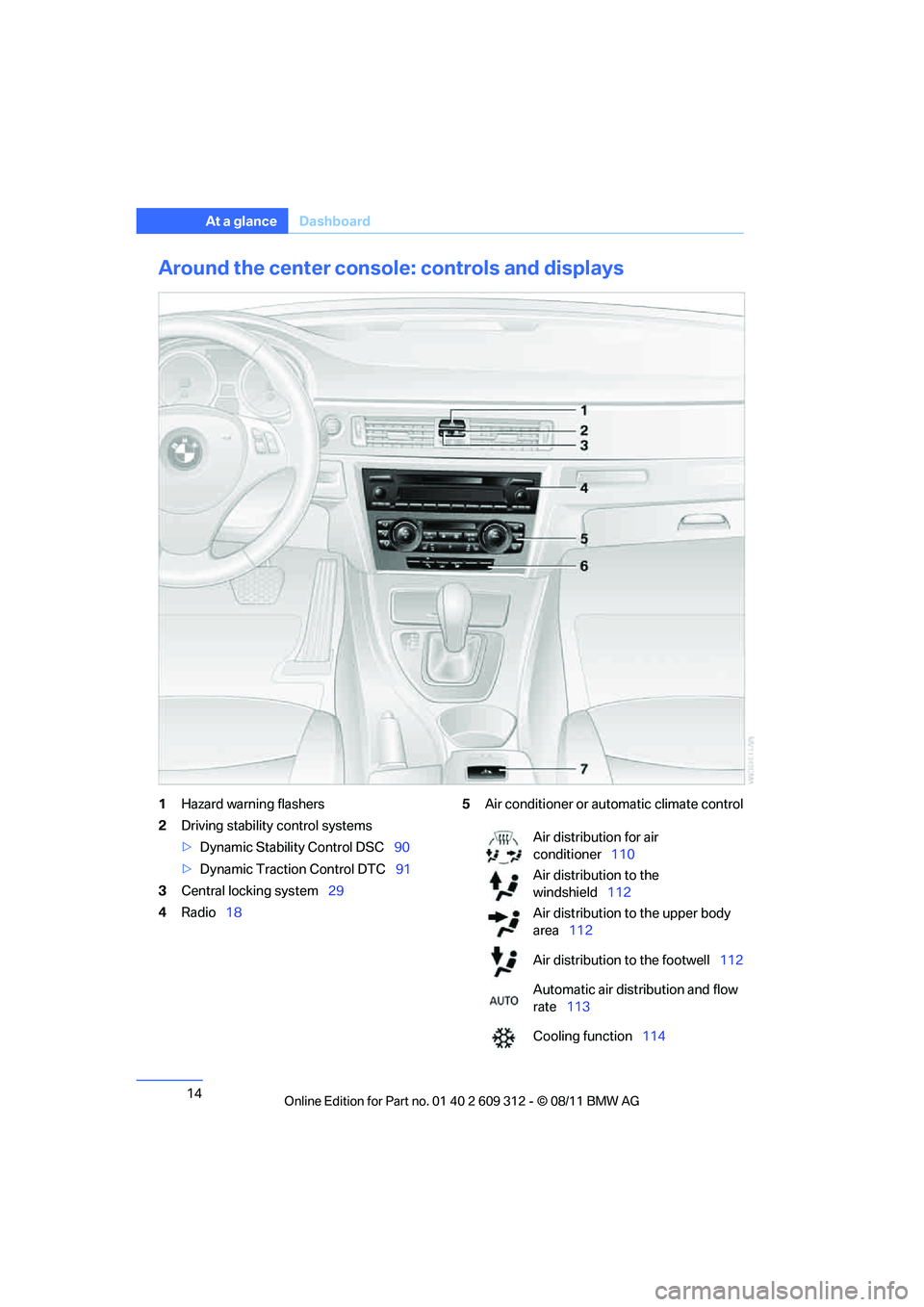
14
At a glanceDashboard
Around the center consol e: controls and displays
1Hazard warning flashers
2 Driving stability control systems
>Dynamic Stability Control DSC 90
> Dynamic Traction Control DTC 91
3 Central locking system 29
4 Radio 18 5
Air conditioner or automatic climate control
Air distribution for air
conditioner 110
Air distribution to the
windshield 112
Air distribution to the upper body
area 112
Air distribution to the footwell 112
Automatic air distribution and flow
rate 113
Cooling function 114
Online Edition for Part no. 01 40 2 609 312 - \251 08/11 BMW AG
Page 67 of 255
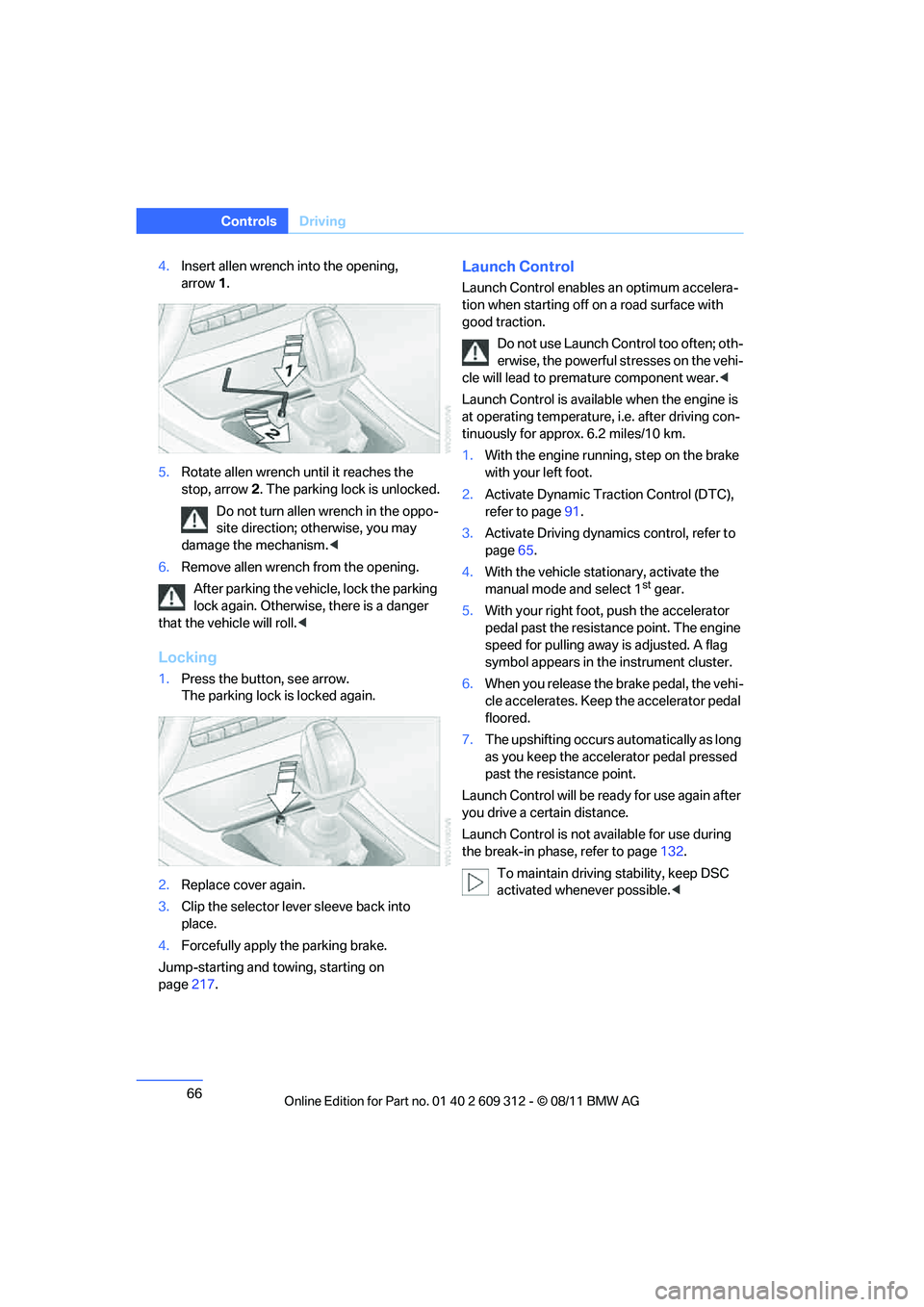
66
ControlsDriving
4.Insert allen wrench into the opening,
arrow 1.
5. Rotate allen wrench until it reaches the
stop, arrow 2. The parking lock is unlocked.
Do not turn allen wrench in the oppo-
site direction; otherwise, you may
damage the mechanism. <
6. Remove allen wrench from the opening.
After parking the vehicle, lock the parking
lock again. Otherwise, there is a danger
that the vehicle will roll. <
Locking
1.Press the button, see arrow.
The parking lock is locked again.
2. Replace cover again.
3. Clip the selector lever sleeve back into
place.
4. Forcefully apply the parking brake.
Jump-starting and towing, starting on
page 217.
Launch Control
Launch Control enables an optimum accelera-
tion when starting off on a road surface with
good traction.
Do not use Launch Control too often; oth-
erwise, the powerful stresses on the vehi-
cle will lead to premature component wear. <
Launch Control is availa ble when the engine is
at operating temperature, i.e. after driving con-
tinuously for approx. 6.2 miles/10 km.
1. With the engine running, step on the brake
with your left foot.
2. Activate Dynamic Trac tion Control (DTC),
refer to page 91.
3. Activate Driving dynami cs control, refer to
page 65.
4. With the vehicle stationary, activate the
manual mode and select 1
stgear.
5. With your right foot, push the accelerator
pedal past the resistance point. The engine
speed for pulling away is adjusted. A flag
symbol appears in the instrument cluster.
6. When you release the brake pedal, the vehi-
cle accelerates. Keep the accelerator pedal
floored.
7. The upshifting occurs automatically as long
as you keep the accelerator pedal pressed
past the resistance point.
Launch Control will be ready for use again after
you drive a certain distance.
Launch Control is not available for use during
the break-in phase, refer to page 132.
To maintain driving stability, keep DSC
activated whenever possible. <
Online Edition for Part no. 01 40 2 609 312 - \251 08/11 BMW AG
Page 75 of 255

74
ControlsDriving
>When the brakes are applied.
> The speed is reduced to below 20 mph or
30 km/h due to a traffic situation.
> When the manual transmission is shifted
very slowly or shifted into neutral.
> When the automatic transmission selector
lever is moved into the neutral position.
> When the selector lever of the Sports auto-
matic transmission with double clutch is
moved into the neutral position.
> When Dynamic Traction Control DTC is
activated.
> When Dynamic Stability Control DSC is
deactivated.
> When DSC or ABS is intervening.
> The system does not recognize any objects
for a longer time, e. g. on infrequently trav-
eled roads without a shoulder or guard rails,
or if the radar sensor is covered with dirt,
refer to page 75.
> The parking brake is engaged.
When the system is deactivated, you
must brake the vehicle yourself and/or
maneuver as necessary; otherwise, there is a
risk of accidents. <
Warning lamp
The warning lamp lights up when
Active Cruise Control has been
automatically deactivated, for exam-
ple due to a driving speed below 20 mph or
30 km/h or a DSC intervention.
Resuming stored desired speed and
distance
Briefly press th e button, arrow 4 .
The stored speed and distance are regained
and maintained.
In the following instance s, the stored speed is
deleted and can no longer be resumed: >
When driving stability control systems are
intervening.
> In cars with manual transmission: when you
shift gears very slowly or shift to neutral.
> In cars with automatic transmission: when
you engage selector lever position N.
> In cars with Sport automatic transmission
with double clutch: when you engage selec-
tor lever position N.
> When the ignition is switched off.
Displays in the instrument cluster
1Stored desired speed
2 Shows yellow: vehicle detected ahead
Flashes in red: system cannot maintain dis-
tance; driver must brake the vehicle
Flashes in yellow: driving stability control
systems are intervening; cruise control is
deactivated
3 Selected distance to vehicle ahead
The indicator lights up as soon as the sys-
tem is activated.
4 Selected desired speed is temporarily dis-
played
If --- mph or --- km/h temporarily appears
in the instrument cluster display, it is pos-
sible that the system prerequisites for operation
are currently not met. Calling up Check Control
messages, refer to page 88.<
Online Edition for Part no. 01 40 2 609 312 - \251 08/11 BMW AG
Page 91 of 255
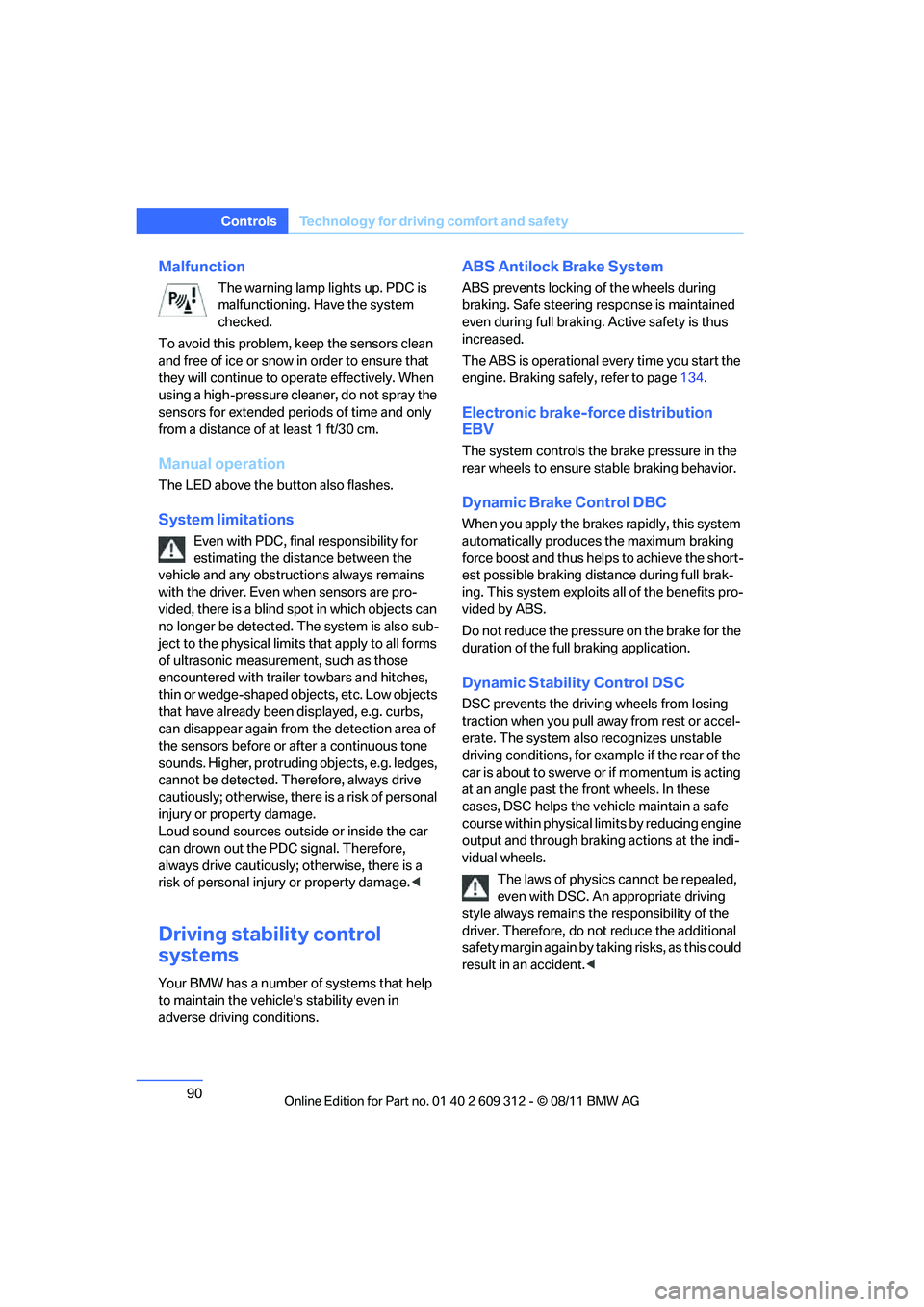
90
ControlsTechnology for driving comfort and safety
Malfunction
The warning lamp lights up. PDC is
malfunctioning. Have the system
checked.
To avoid this problem, keep the sensors clean
and free of ice or snow in order to ensure that
they will continue to op erate effectively. When
using a high-pressure cleaner, do not spray the
sensors for extended periods of time and only
from a distance of at least 1 ft/30 cm.
Manual operation
The LED above the button also flashes.
System limitations
Even with PDC, final responsibility for
estimating the distance between the
vehicle and any obstructions always remains
with the driver. Even when sensors are pro-
vided, there is a blind sp ot in which objects can
no longer be detected. The system is also sub-
ject to the physical limits that apply to all forms
of ultrasonic measurement, such as those
encountered with traile r towbars and hitches,
thin or wedge-shaped objects, etc. Low objects
that have already been displayed, e.g. curbs,
can disappear again from the detection area of
the sensors before or af ter a continuous tone
sounds. Higher, protruding objects, e.g. ledges,
cannot be detected. Therefore, always drive
cautiously; otherwise, there is a risk of personal
injury or property damage.
Loud sound sources outside or inside the car
can drown out the PDC signal. Therefore,
always drive cautiously; otherwise, there is a
risk of personal injury or property damage. <
Driving stability control
systems
Your BMW has a number of systems that help
to maintain the vehicle's stability even in
adverse driving conditions.
ABS Antilock Brake System
ABS prevents locking of the wheels during
braking. Safe steering response is maintained
even during full braking. Active safety is thus
increased.
The ABS is operational every time you start the
engine. Braking safely, refer to page 134.
Electronic brake-force distribution
EBV
The system controls the brake pressure in the
rear wheels to ensure stable braking behavior.
Dynamic Brake Control DBC
When you apply the brakes rapidly, this system
automatically produces the maximum braking
force boost and thus helps to achieve the short-
est possible braking distance during full brak-
ing. This system exploits all of the benefits pro-
vided by ABS.
Do not reduce the pressu re on the brake for the
duration of the full braking application.
Dynamic Stability Control DSC
DSC prevents the driving wheels from losing
traction when you pull away from rest or accel-
erate. The system also recognizes unstable
driving conditions, for example if the rear of the
car is about to swerve or if momentum is acting
at an angle past the front wheels. In these
cases, DSC helps the vehicle maintain a safe
course within physical lim its by reducing engine
output and through braking actions at the indi-
vidual wheels.
The laws of physics cannot be repealed,
even with DSC. An appropriate driving
style always remains th e responsibility of the
driver. Therefore, do not reduce the additional
safety margin again by taki ng risks, as this could
result in an accident. <
Online Edition for Part no. 01 40 2 609 312 - \251 08/11 BMW AG
Page 92 of 255

91
Technology for driving comfort and safety
Controls
Deactivating DSC
Press the button for at le
ast 3 seconds until the
indicator lamp for DSC OFF lights up and DSC
OFF is displayed in the instrument cluster.
Dynamic Traction Cont rol DTC and DSC have
been simultaneously de activated. Stabilizing
and drive-output promoting actions are no
longer executed.
In the same way as with a differential interlock,
even if DSC is deactivated, brake actions are
still performed to enhance drive output if the
drive wheels experience a significant loss of
traction.
To increase vehicle stability, activate DSC again
as soon as possible.
Activating DSC
Press the button again; th e indicator lamp in the
instrument cluster goes out.
For better control
If the indicator lamp flashes: the DSC
controls the driving and braking forces.
If the indicator lamp lights up: DSC and
DTC have failed.
The indicator lamp lights up and
DSC OFF is displayed in the instrument
cluster: DSC is deactivated.
Dynamic Traction Control DTC
DTC is a version of DSC in which the drive out-
put is optimized for part icular road conditions,
e.g. unplowed snow-covered roads. The sys-
tem assures the maximal drive output, but with
reduced driving stability. It is therefore neces-
sary to drive with appropriate caution.
You may find it useful to briefly activate DTC
under the following special circumstances:
> When driving uphill on snow-covered roads,
in slush or on unplowed, snow-covered
roads
> When rocking a stuck vehicle free or start-
ing off in deep snow or on loose ground
> When driving with snow chains
Activating DTC
Press the button; the indicator lamp for DSC
OFF lights up and TRACTION is displayed in
the instrument cluster.
For better control
If the indicator lamp flashes: DTC con-
trols the driving and braking forces.
If the indicator lamp lights up: DSC and
DTC have failed.
The indicator lamp lights up and
TRACTION is displayed in the instru-
ment cluster: DTC is activated.
Deactivating DTC
Press the button again; th e indicator lamp in the
instrument cluster goes out.
Online Edition for Part no. 01 40 2 609 312 - \251 08/11 BMW AG
Page 93 of 255
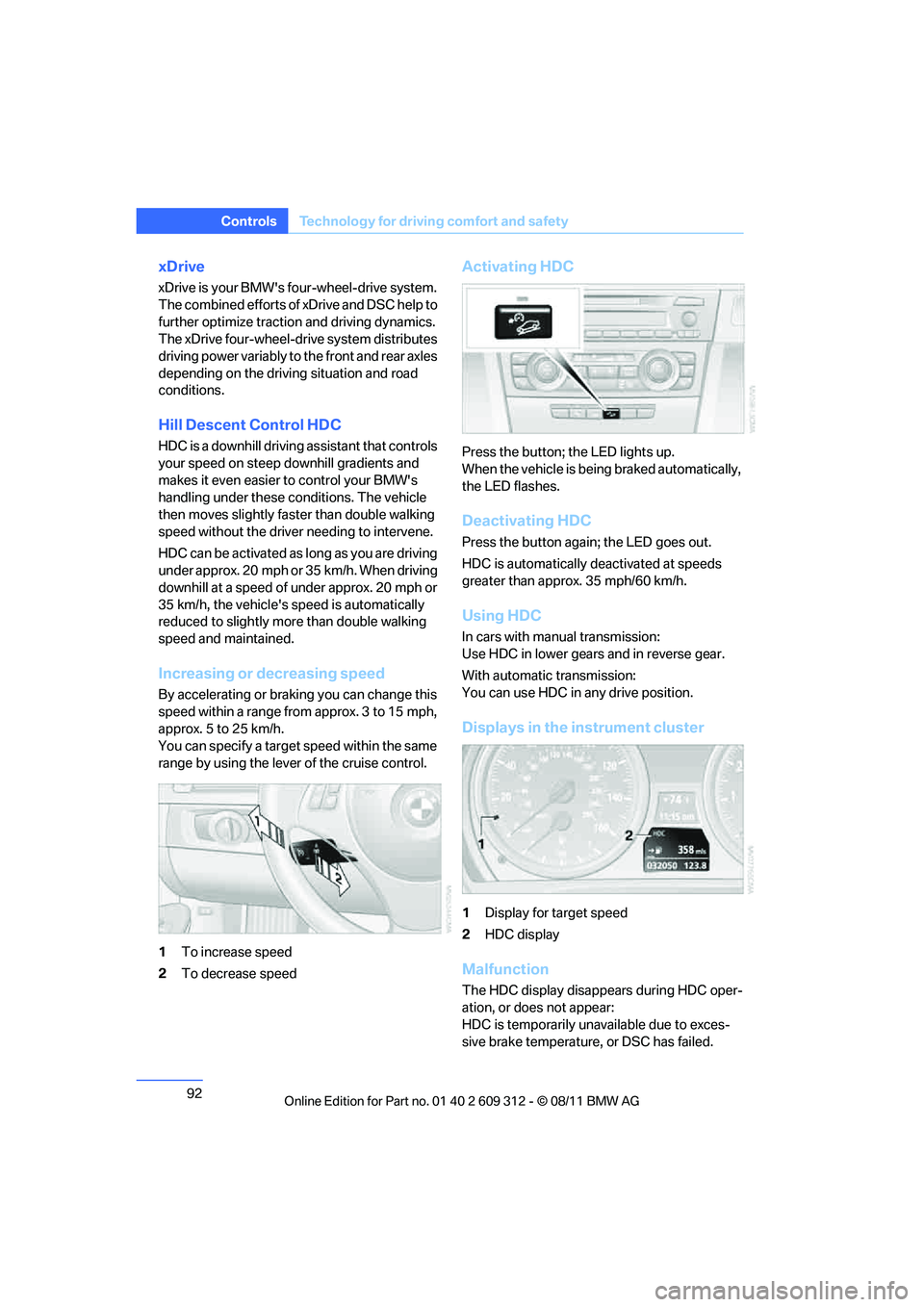
92
ControlsTechnology for driving comfort and safety
xDrive
xDrive is your BMW's four-wheel-drive system.
The combined efforts of xDrive and DSC help to
further optimize traction and driving dynamics.
The xDrive four-wheel-drive system distributes
driving power variably to the front and rear axles
depending on the drivin g situation and road
conditions.
Hill Descent Control HDC
HDC is a downhill driving assistant that controls
your speed on steep downhill gradients and
makes it even easier to control your BMW's
handling under these conditions. The vehicle
then moves slightly faster than double walking
speed without the driver needing to intervene.
HDC can be activated as long as you are driving
under approx. 20 mph or 35 km/h. When driving
downhill at a speed of under approx. 20 mph or
35 km/h, the vehicle's speed is automatically
reduced to slightly more than double walking
speed and maintained.
Increasing or de creasing speed
By accelerating or braking you can change this
speed within a range from approx. 3 to 15 mph,
approx. 5 to 25 km/h.
You can specify a target speed within the same
range by using the lever of the cruise control.
1To increase speed
2 To decrease speed
Activating HDC
Press the button; the LED lights up.
When the vehicle is being braked automatically,
the LED flashes.
Deactivating HDC
Press the button again; the LED goes out.
HDC is automatically deactivated at speeds
greater than approx. 35 mph/60 km/h.
Using HDC
In cars with manual transmission:
Use HDC in lower gears and in reverse gear.
With automatic transmission:
You can use HDC in any drive position.
Displays in the instrument cluster
1Display for target speed
2 HDC display
Malfunction
The HDC display disappe ars during HDC oper-
ation, or does not appear:
HDC is temporarily unavailable due to exces-
sive brake temperature, or DSC has failed.
Online Edition for Part no. 01 40 2 609 312 - \251 08/11 BMW AG
Page 194 of 255

193
Wheels and tires
Mobility
Tire identification marks
Knowledge of the labeling on the side of the tire
makes it easier to identi
fy and choose the right
tires.
Tire size
Speed code letter
Q = up to 100 mph or 160 km/h
T = up to 118 mph or 190 km/h
H = up to 131 mph or 210 km/h
V = up to 150 mph or 240 km/h
W = up to 167 mph or 270 km/h
Y = up to 186 mph or 300 km/h
Tire Identification Number
Tires with DOT codes meet the guidelines of
the US Department of Transportation.
DOT code:
Tire age
The manufacturing date of tires is contained in
the tire coding: DOT … 1011 means that the
tire was manufactured in week 10 of 2011.
BMW recommends that you replace all tires
after 6 years at most, even if some tires may last
for 10 years.
Uniform Tire Quality Grading
Quality grades can be found where applicable
on the tire sidewall between tread shoulder and
maximum section width. For example:
Tread wear 200 Traction AA
Temperature A
DOT Quality Grades
Tread wear
Traction AA A B C
Temperature A B C
All passenger car tires must conform to
Federal Safety Requir ements in addition
to these grades. <
Tread wear
The tread wear grade is a comparative rating
based on the wear rate of the tire when tested
under controlled conditions on a specified gov-
ernment test course. For example, a tire graded
150 would wear one and one-half (1 γ) times as
well on the government course as a tire graded
100. The relative performance of tires depends
upon the actual conditio ns of their use, how-
ever, and may depart significantly from the
norm due to variations in driving habits, service
practices and differences in road characteris-
tics and climate.
Traction
The traction grades, from highest to lowest, are
AA, A, B, and C.
Those grades represent the tire's ability to stop
on wet pavement as measured under controlled
conditions on specifie d government test sur-
faces of asphalt and concrete. A tire marked C
may have poor traction performance.
The traction grade assigned to this tire is
based on straight-ahead braking traction
tests, and does not include acceleration, cor-
nering, hydroplaning, or peak traction charac-
teristics. <
e.g.
Nominal width in mm
Aspect ratio in
Ξ
Radial belt construction
Rim diameter in inches
Load rating, not on ZR tires
Speed code letter, in
front of the R on ZR tires
225/45 R1791 V
e.g.
Manufacturer's
code for tire make
Tire size and tire design
Tire ageDOT xxxx xxx 1011
Online Edition for Part no. 01 40 2 609 312 - \251 08/11 BMW AG
Page 226 of 255
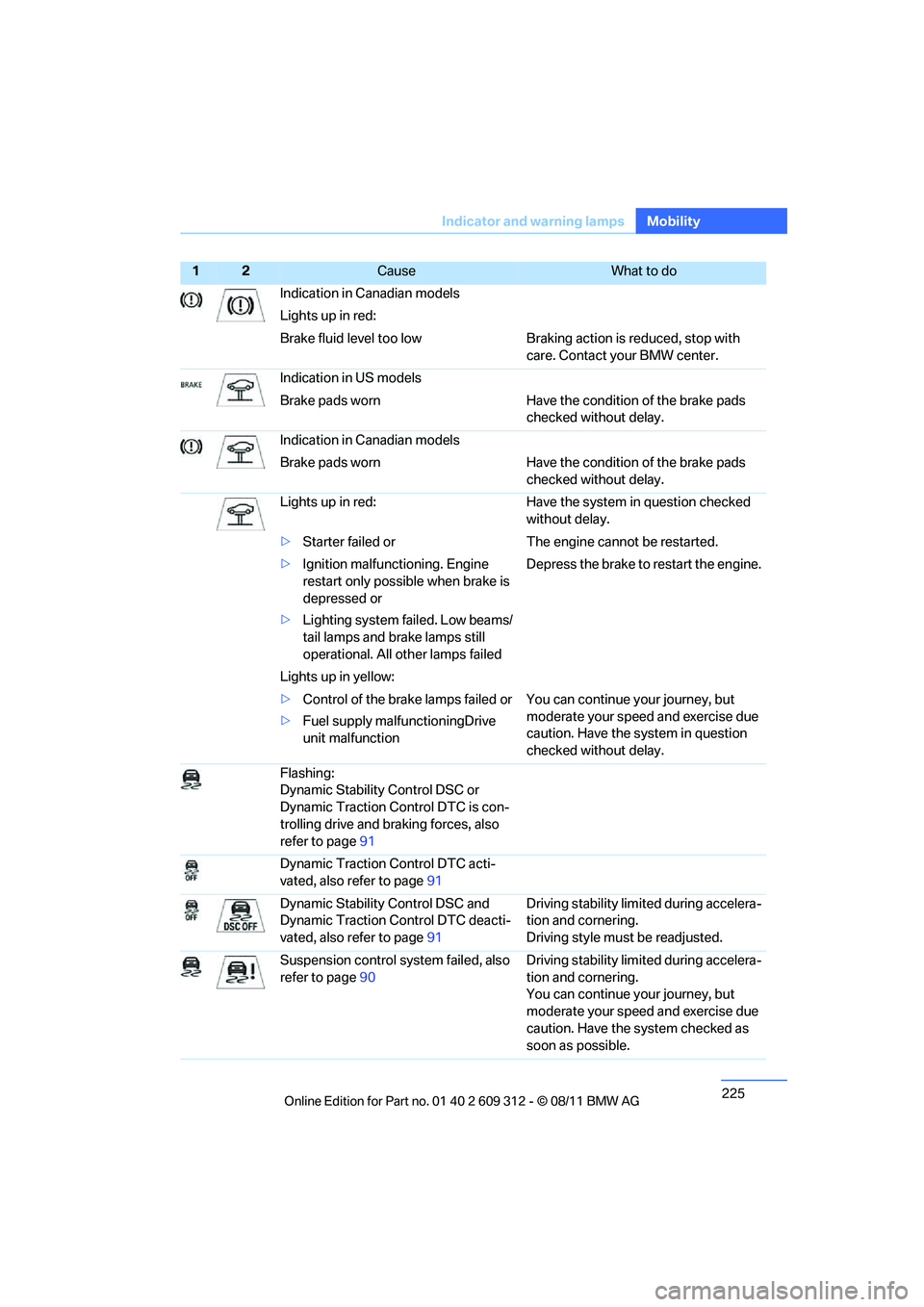
225
Indicator and warning lamps
Mobility
Indication in Canadian models
Lights up in red:
Brake fluid level too low Braking action is reduced, stop with
care. Contact your BMW center.
Indication in US models
Brake pads worn Have the condition of the brake pads checked without delay.
Indication in Canadian models
Brake pads worn Have the condition of the brake pads checked without delay.
Lights up in red: Have the system in question checked without delay.
> Starter failed or The engine cannot be restarted.
> Ignition malfunctioning. Engine
restart only possible when brake is
depressed or
> Lighting system failed. Low beams/
tail lamps and brake lamps still
operational. All other lamps failed Depress the brake to restart the engine.
Lights up in yellow:
> Control of the brake lamps failed or
> Fuel supply malfunctioningDrive
unit malfunction You can continue your journey, but
moderate your speed and exercise due
caution. Have the system in question
checked without delay.
Flashing:
Dynamic Stability Control DSC or
Dynamic Traction Control DTC is con-
trolling drive and braking forces, also
refer to page 91
Dynamic Traction Control DTC acti-
vated, also refer to page 91
Dynamic Stability Control DSC and
Dynamic Traction Control DTC deacti-
vated, also refer to page 91Driving stability limited during accelera-
tion and cornering.
Driving style must be readjusted.
Suspension control system failed, also
refer to page 90 Driving stability limited during accelera-
tion and cornering.
You can continue your journey, but
moderate your speed and exercise due
caution. Have the system checked as
soon as possible.
12Cause What to do
Online Edition for Part no. 01 40 2 609 312 - \251 08/11 BMW AG
Page 245 of 255
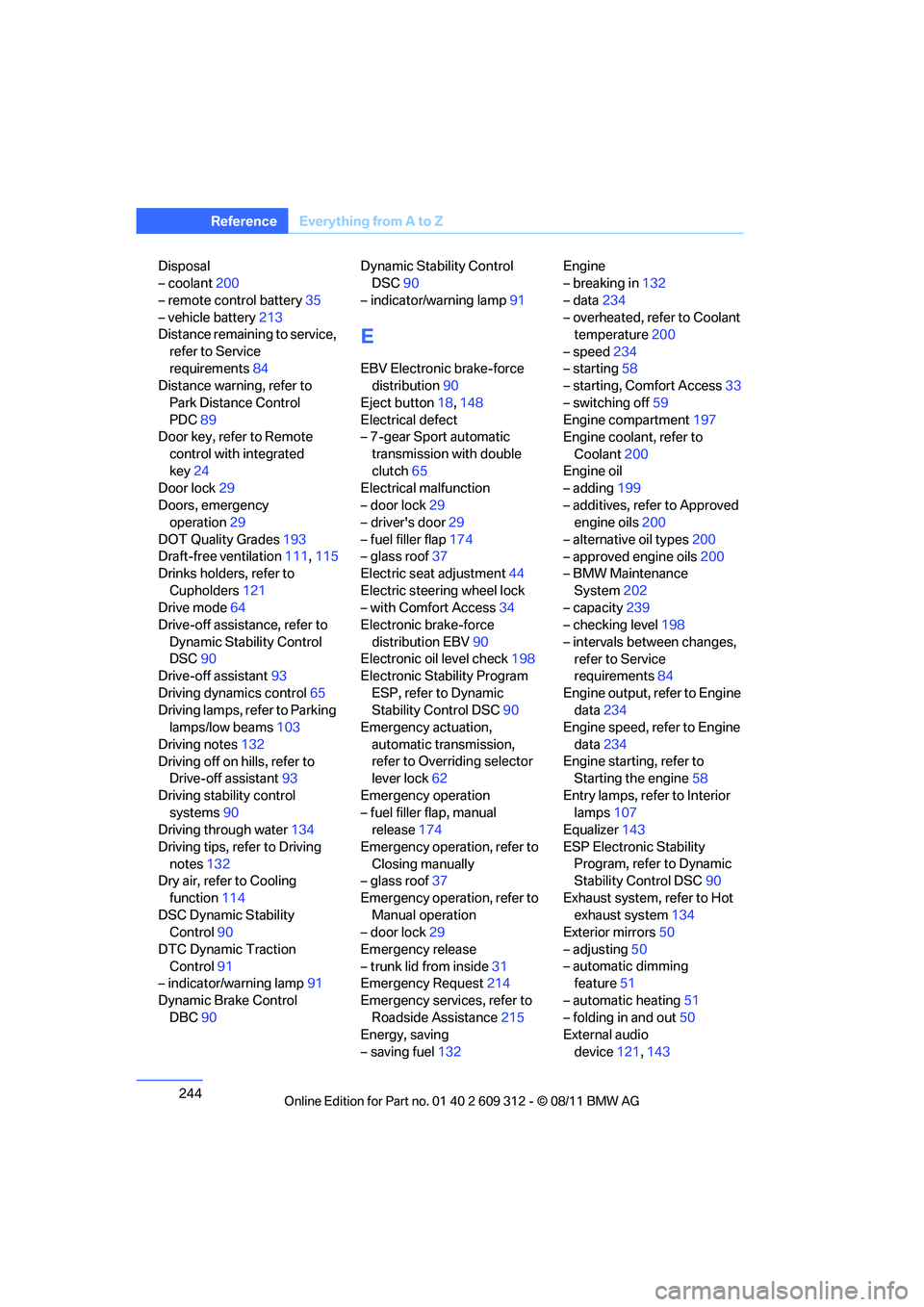
244
ReferenceEverything from A to Z
Disposal
– coolant200
– remote control battery 35
– vehicle battery 213
Distance remaining to service,
refer to Service
requirements 84
Distance warning, refer to
Park Distance Control
PDC 89
Door key, refer to Remote
control with integrated
key 24
Door lock 29
Doors, emergency operation 29
DOT Quality Grades 193
Draft-free ventilation 111,115
Drinks holders, refer to
Cupholders 121
Drive mode 64
Drive-off assistance, refer to
Dynamic Stability Control
DSC 90
Drive-off assistant 93
Driving dynamics control 65
Driving lamps, refer to Parking lamps/low beams 103
Driving notes 132
Driving off on hills, refer to Drive-off assistant 93
Driving stability control systems 90
Driving through water 134
Driving tips, refer to Driving notes 132
Dry air, refer to Cooling
function 114
DSC Dynamic Stability Control 90
DTC Dynamic Traction Control 91
– indicator/warning lamp 91
Dynamic Brake Control DBC 90 Dynamic Stability Control
DSC 90
– indicator/warning lamp 91
E
EBV Electronic brake-force
distribution 90
Eject button 18,148
Electrical defect
– 7-gear Sport automatic
transmission with double
clutch 65
Electrical malfunction
– door lock 29
– driver's door 29
– fuel filler flap 174
– glass roof 37
Electric seat adjustment 44
Electric steering wheel lock
– with Comfort Access 34
Electronic brake-force
distribution EBV 90
Electronic oil level check 198
Electronic Stability Program
ESP, refer to Dynamic
Stability Control DSC 90
Emergency actuation,
automatic transmission,
refer to Overriding selector
lever lock 62
Emergency operation
– fuel filler flap, manual release 174
Emergency operation, refer to Closing manually
– glass roof 37
Emergency operation, refer to Manual operation
– door lock 29
Emergency release
– trunk lid from inside 31
Emergency Request 214
Emergency services, refer to Roadside Assistance 215
Energy, saving
– saving fuel 132 Engine
– breaking in
132
– data 234
– overheated, refer to Coolant temperature 200
– speed 234
– starting 58
– starting, Comfort Access 33
– switching off 59
Engine compartment 197
Engine coolant, refer to
Coolant 200
Engine oil
– adding 199
– additives, refer to Approved engine oils 200
– alternative oil types 200
– approved engine oils 200
– BMW Maintenance
System 202
– capacity 239
– checking level 198
– intervals between changes, refer to Service
requirements 84
Engine output, refer to Engine data 234
Engine speed, ref
er to Engine
data 234
Engine starting, refer to Starting the engine 58
Entry lamps, refer to Interior lamps 107
Equalizer 143
ESP Electronic Stability Program, refer to Dynamic
Stability Control DSC 90
Exhaust system, refer to Hot exhaust system 134
Exterior mirrors 50
– adjusting 50
– automatic dimming feature 51
– automatic heating 51
– folding in and out 50
External audio
device 121,143
Online Edition for Part no. 01 40 2 609 312 - \251 08/11 BMW AG
Page 253 of 255

252
ReferenceEverything from A to Z
Tire Pressure Monitor
TPM 95
– resetting the system 95
– system limitations 95
– warning lamp 96
Tire puncture, refer to Flat Tire Monitor 94
Tire Quality Grading 193
Tires
– age 193,195
– air loss 96
– breaking in 132
– changing, refer to Changing wheels 211
– condition 194
– damage 194
– inflation pressure 177
– labels 193
– minimum tread depth 194
– new wheels and tires 195
– pressure monitoring, refer to Flat Tire Monitor 93
– pressure monitoring, refer to Tire Pressure Monitor
TPM 95
– puncture 94
– replacing 195
– Run-flat tires 196
– size 193
– storage 196
– tread depth 194
– wear indicators, refer to Minimum tread depth 194
– wheel/tire combination, refer
to Correct wheels and
tires 195
– winter tires 196
Tone
– control 143
– middle setting 144
Tools, refer to Onboard vehicle tool kit 208
Top, refer to Retractable
hardtop 38
Torque, refer to Engine data 234 Tow bar
218
Tow fitting 217
– screw thread 217
Tow fittings for tow-starting and towing away 217
Towing 217
– car with automatic transmission 217
– methods 218
– with 7-gear Sport automatic transmission with double
clutch 218
Towing and tow-starting 217
Tow rope 218
Tow-s
tarting 217,219
TPM, refer to Tire Pressure
Monitor 95
Traction control, refer to Dynamic Stability Control
DSC 90
Transmission
– 7-gear Sport automatic
transmission with double
clutch 62
– automatic transmission with
Steptronic 60
– idle position 63
– Launch Control 66
– manually unlocking parking lock 65
– manual transmission 60
– overriding selector lever lock for automatic transmission
with Steptronic 62
– reverse gear 63
Transmission interlock
– refer to Changing selector
lever position 60
– refer to P Park 60
Transporting children
safely 53
Transport securing devices, refer to Securing cargo 137
Tread depth, refer to Minimum tire tread 194 Trip-distance coun
ter, refer to
Trip odometer 78
Triple turn signal activation 67
Trip odometer 78
Trunk lid 31
– Comfort Access 34
– emergency release 31
– locking or unlocking
separately 31
– opening from inside 31
– opening from outside 31
– remote control 27
Turning circle, refer to Dimensions 235
Turn signal 67
Turn signal indicators
– indicator/warning lamp 12
Turn signals
– triple turn signal 67
Tying down loads, refer to Cargo loading 137
U
Uniform Tire Quality Grading/
UTQR 193
Units
– average fuel
consumption 83
Units of measure
– temperature 83
Universal garage door opener, refer to Integrated universal
remote control 116
Unlatching, refer to Unlocking 33
Unlocking
– from inside 30
– from outside 25
– setting unlocking
characteristics 26
– trunk lid 34
– without remote control, refer
to Comfort Access 33
USB audio interface 151
Online Edition for Part no. 01 40 2 609 312 - \251 08/11 BMW AG